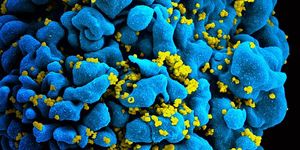Mutant Crayfish, Ready for Takeover
What was probably an accident at a pet store has perhaps led us to the plot of a terrible movie: mutant crayfish are poised for world domination. After being created roughly two decades ago, they have spread across Europe and even to Africa, wreaking havoc on native species and ecosystems.
It is suspected that around 1995, a reproductive mistake led to the development of an invasive species. Two slough crayfish imported from Florida to Germany were mated. It was suspected that the mating produced an animal with three sets of 92 chromosomes instead of the usual two. One parent may have contributed an unusual egg or sperm with the extra chromosome, allowing the pairing to create a new species. Some scientists have suggested that this coupling could have occurred in the wild though; we have no real way to know precisely when or how it happened.
One of the only crayfish species that can reproduce asexually, this female marbled crayfish makes clones of itself from unfertilized eggs. Analysis of progeny taken from all over the globe has indicated that indeed, they are all clones of each other. It took fifteen years for scientists to piece together the genome of the marbled crayfish; it was confirmed that it evolved from Procambarus fallax, or slough crayfish originating in the Satilla River in Florida and Georgia.
"It is mere speculation that it originated in captivity," said Gerhard Scholtz, an evolutionary biologist at Humboldt University in Berlin who has tracked them around the globe. Genomic analysis of marbled crayfish DNA from across Europe and Africa "shows that all these crayfish are clones - with identical genomes the world over," he added.
Putting the origin of the species aside, it can survive in many places. Usually being a clone would be assumed to be a disadvantage; there is often little room for adaptability for such an animal. But, this crayfish is thriving in many different conditions with varied temperatures, acidities, and salinities.
"This paper suggests that an animal species can rapidly invade a large geographical area despite reproducing without sex and being clonal," Etienne Danchin, an evolutionary biologist at the National Institute of Agricultural Research in Sophia-Antipolis, France told Science News.
It could be that the third chromosome is a big help to this invader. These crayfish have been found in many places, including Japan and Madagascar, where they are posing a major threat to native species. Time will tell how far they go, and how long the species survives.
"Maybe they just survive for 100,000 years," commented Frank Lyko, a molecular geneticist at the German Cancer Research Center in Heidelberg, who has been studying the crayfish for years. "That would be a long time for me personally, but in evolution, it would just be a blip on the radar."
Sources: Science News, IB Times









